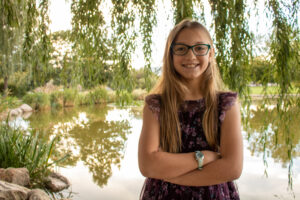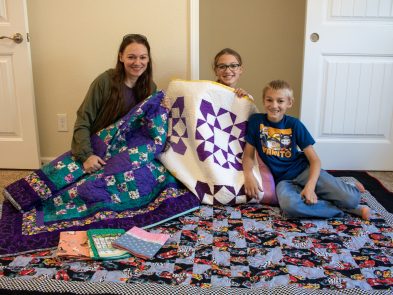Home dedicated Sept. 21, 2024
Miranda's Family Story
Miranda is a single mom of two preteen children. After her divorce, she and her kids lived with her parents on the eastern plains of Colorado, then she moved to El Paso County in 2016 to attend UCCS.
“I chose Colorado Springs because at that time, it was a really affordable city that offered all the things I wanted to offer my kids, with sports and schools and opportunities,” she explains. “My goal was one day I would be able to afford one of the condos around me.”
But housing costs have risen precipitously since then, leaving Miranda—like many other workforce employees—priced out of the market.
“I’m in a rut where we’ve outgrown our current living situation, but I can’t afford to go anywhere else,” she says. Her kids share a room, and “Everything in our apartment has at least two uses!” she laughs. “We’ve got extra pantry storage in the laundry room. Nothing makes sense, but it works because we are bursting at the seams.”
Like many renters, she finds that the precariousness of the housing market takes a toll.

“I’m very grateful for what we have,” she says. “It’s just like an anxiety attack every 12 months when the lease comes up, because there’s no protection for renters. So if they wanted to—which, thank God, they haven’t—they could increase my rent by $500 and I could do nothing about it. There was a point in time where they weren’t even offering full-length leases. They were only doing six-month leases, so it was like every six months it’s a panic attack, like living on eggshells.”
But she adds, “I’m very grateful because I know that a lot of people’s situations are a lot worse.”
And she points out that living in an apartment has taught her children valuable lessons. “I think they’ve learned a lot of respect for people around us, because it’s like, ‘Hey, you can’t run, you can’t jump, you can’t yell,’” she says. “It’s a lot of can’ts, but it’s to be respectful of those around you.”
Despite the rising cost of living, she and her kids want to stay in El Paso County. “We have a life here, so even though it’s not as affordable as it once was, we are rooted here now,” she says.
That desire led her to apply to Pikes Peak Habitat’s homeownership program.
“You want the best for [your kids] so badly,” she says. “The biggest part of my heart is the happiest because they get what they deserve!”
She’s worked to make their apartment feel like home, but it isn’t the same as having a house of their own. “There’s a difference between it being yours, where you can change the color of the walls; you can hang up a picture frame if you want to,” she says. “I’m looking forward to the sense of ownership, the pride in ownership.”
Her kids are excited to have their own rooms, and they’re already discussing plans for a Nerf wall and a ballet mirror. Miranda also looks forward to “teaching them how to care for their house,” she says. “They can be kids in a house more than they can be in an apartment.”

For her part, she looks forward to having a yard. “I miss gardening, and I’ve tried in our apartment to have a patio garden with potted plants. It’s just not the same!” she explains. “So I’m excited to have a yard and garden and have the kids pick carrots when they want to.”
They also anticipate adding a puppy to their lives. The elderly dog who had been her children’s lifelong companion passed last winter, and Miranda told her children that once they have a fenced yard, they can get another dog.
“Now when we have a home, they’ll be able to be kids running and yelling and jumping and being whatever they want to be, within reason!” she says.
She’s also happy to be moving to a community that’s so child-friendly.
“I’ve driven my kids through the neighborhood, and we’ve seen kids playing in the streets,” she says. “I’m excited for them to be able to play with kids in the neighborhood, like I did when I grew up!”
She’s already getting to know some of those kids, and their parents, through her sweat equity.
“I really hit it off with another one of the homeowners that is moving in this year,” Miranda notes. “They’ve got kids that are my kids’ age, so it’s exciting because it’s already building a community!”
One day, she helped lay sod—something she says she’d be happy never to do again!—for another Pikes Peak Habitat homeowner, whose kids are also the same ages as hers.
On another day, she was working alongside a fellow future homeowner when one of the construction staff asked if they wanted to see the location of their homes. They did—and realized they would be living next to each other! “I’ve already met my next-door neighbor, even though it won’t happen for a year,” she enthuses. “That’s really cool, because that doesn’t happen, ever!”
Not only is sweat equity giving her a chance to build relationships before she even moves into her new home, but Miranda says it’s also equipping her to care for her property.
“I should have a base knowledge after this whole experience, because I’ve already done grout sealing for a house. I’ve already laid sod,” she says. “It’s the confidence that anything that happens in my home, I can figure it out, because I’ve done all of these things now.”
Miranda looks forward to the future with hope and says she and her children are focused on “what we’re coming into.” She believes the Habitat process—investing sweat equity, meeting future neighbors, and working alongside volunteers—is “the way it should be, a model for what it should be like: communities coming together to help each other.” She concludes, “It’s a year from now that it’s going to come to fruition, but it’s already becoming our community!”
See Miranda on the news!
Pikes Peak Habitat for Humanity Celebrates the 20th Anniversary of its Store Called ReStore (KOAA News5, Jan. 17)



About the Fund for Humanity
Created in 1968 and predating the establishment of Habitat for Humanity International, the Fund for Humanity began as the method of accomplishing partnership housing at Koinonia Farm. The concept centered on those in need of adequate shelter working side by side with volunteers to build decent, affordable houses. The houses would be built at no profit. New homeowners’ house payments would be combined with no-interest loans provided by supporters and money earned by fundraising to create “The Fund for Humanity,” which would then be used to build more homes.

Today, The Fund for Humanity refers to a collection of funding sources, including capital from loan sale programs, loan payoffs, monthly Habitat mortgage payments, unrestricted fundraising, and net proceeds from the ReStore.
The Fund for Humanity helps finance every home we build! However, a Fund for Humanity Build references a home that was wholly supported by the Fund.







